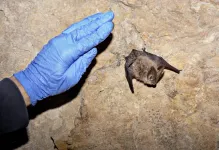(Press-News.org) WASHINGTON, January 19, 2021 -- A Velcro-like fastener with a microscopic design that looks like tiny mushrooms could mean advances for everyday consumers and scientific fields like robotics.
In Biointerphases, published by AIP Publishing, researchers from Wageningen University in the Netherlands show how the design can use softer materials and still be strong enough to work.
Probabilistic fasteners work, because they are designed with a tiny pattern on one surface that interlocks with features on the other surface. Currently available fasteners, like Velcro and 3M, are called hook and loop fasteners. That design requires harder, stiff material, which is what causes the loud ripping sound when they are peeled off and why they can damage delicate surfaces, such as fabrics, when attached to them.
The team believes a 3D mushroom design can be made with softer, more flexible materials. The half-spherical mushroom shapes provide sufficient interlocking force on the fabric and hold strong.
For the study, the authors used 3D printing combined with molding to create soft surfaces patterned with the tiny mushrooms. That material was then safely attached to three different fabrics and removed without causing damage to them.
"We wanted to prove that, if you go toward these less stiff features, they can be used to attach and detach to soft and delicate surfaces, like fabrics, without damage. It can be used in many applications such as for diapers or silent fasteners for military use," author Preeti Sharma said. "There is still a lot of research to be done, but the mushroom-shaped design worked quite well for soft mechanical fasteners."
The design could lead to advances in the field of soft robotics. Soft robotics aims to build robots with designs that mimic living creatures like octopuses, caterpillars, and worms.
In that kind of robotics, interfaces play a significant role. With advances that make the current mushroom design stronger but keep its softness, it could be used to help robots walk on walls and ceilings like a gecko -- an animal that can do that because of an attachment-detachment process that's similar to how probabilistic fasteners work.
The design also could be used on grippers for robots used in farming and other agricultural jobs, Sharma said.
Sharma said more research into the design is needed before it is ready to be used in a commercially available product. Minor changes to the mushroom shape, possibly lengthening or shortening it to make it more effective, could lead to an even better product, she said.
INFORMATION:
The article "Hooked on mushrooms: Preparation and mechanics of a bioinspired soft probabilistic fastener" is authored by Preeti Sharma, Vittorio Saggiomo, Vincent van der Doef, Marleen Kamperman, and Joshua Dijksman. The article appears in Biointerphases on Jan. 19, 2021 (DOI: 10.1116/6.0000634) and can be accessed at https://aip.scitation.org/doi/10.1116/6.0000634.
ABOUT THE JOURNAL
Biointerphases, an AVS journal published by AIP Publishing, emphasizes quantitative characterization of biomaterials and biological interfaces. As an interdisciplinary journal, a strong foundation of chemistry, physics, biology, engineering, theory, and/or modelling is incorporated into originated articles, reviews, and opinionated essays. See https://avs.scitation.org/journal/bip.
ABOUT AVS
AVS is an interdisciplinary, professional society with some 4,500 members worldwide. Founded in 1953, AVS hosts local and international meetings, publishes four journals, serves members through awards, training and career services programs and supports networking among academic, industrial, government, and consulting professionals. Its members come from across the fields of chemistry, physics, biology, mathematics, engineering and business and share a common interest in basic science, technology development and commercialization related to materials, interfaces, and processing.
Even prior to the pandemic, burnout among health care professionals was a pervasive public health concern, with END ...
Large-scale land acquisitions by foreign investors, intended to improve global food security, had little to no benefit, increasing crop production in some areas while simultaneously threatening local food security in others, according to researchers who studied their effects.
The END ...
CORVALLIS, Ore. - Tiny amounts of gender bias in employee hiring decisions contribute to concerning rates of discrimination and productivity losses that together represent significant costs, financial and otherwise, for employers, a new study from Oregon State University has found.
Gender bias is a subtle, unintentional preference for one gender over the other. Despite significant efforts to reduce bias in hiring over the last several decades, it continues to persist and pose potential problems for companies, said Jay Hardy, an assistant professor of management in OSU's College ...
BOZEMAN, Montana (January 19, 2021) - A four-year study recently published in Ecology and Evolution concludes that the fungal disease, white-nose syndrome, poses a severe threat to many western North American bats.
Since it was first detected in 2006, white-nose syndrome has killed millions of bats in eastern and central North America. The spread of the fungal pathogen that causes white-nose syndrome in hibernating bats has reached several western U.S. states, mostly likely through bat-to-bat spread, and is presently threatening western species.
Bats with white-nose syndrome have fungus growing on their nose and wings, as the name implies, but the fungal infection also triggers a higher frequency of arousals from hibernation. ...
Anyone who has tried and failed to meditate knows that our minds are rarely still. But where do they roam? New research led by UC Berkeley has come up with a way to track the flow of our internal thought processes and signal whether our minds are focused, fixated or wandering.
Using an electroencephalogram (EEG) to measure brain activity while people performed mundane attention tasks, researchers identified brain signals that reveal when the mind is not focused on the task at hand or aimlessly wandering, especially after concentrating on an assignment.
Specifically, increased alpha brain waves were detected in the prefrontal cortex of ...
For the first time, scientists have successfully used satellite cameras coupled with deep learning to count animals in complex geographical landscapes, taking conservationists an important step forward in monitoring populations of endangered species.
For this research, the satellite Worldview 3 used high-resolution imagery to capture African elephants moving through forests and grasslands. The automated system detected animals with the same accuracy as humans are able to achieve.
The algorithm that enabled the detection process was created by Dr Olga Isupova, a computer scientist at the University of Bath in the UK. The project was a collaboration with the UK's University of Oxford and the University of Twente in the Netherlands.
Dr ...
People's fear of 5G technology is rational. Such technology does emit radiation, even if it's at low levels. But 5G isn't all that different from 4G, and it certainly doesn't cause COVID-19 despite such rumors having spread rapidly across the globe.
Researchers need to better understand how misinformation like this spreads in order to hone their intervention efforts and prevent misinformed perspectives from taking root. In society's virtual world, preventing technological misinformation, in particular, is important now more than ever.
A research team led by Elaine Nsoesie, a Hariri Institute Faculty Fellow, investigated how COVID-19 misinformation proliferated using ...
A new study out of the University of Chicago and Stanford University on pairs of twins with and without food allergies has identified potential microbial players in this condition. The results were published on Jan. 19 in the Journal of Clinical Investigation.
The study grew out of prior research in the Nagler laboratory at UChicago on the fecal microbiota in infants. By transplanting fecal microbes from healthy and food-allergic infants to germ-free mice (who do not possess a microbiome), investigators found that the healthy infant microbiota was protective against the development ...
The synthetic chemicals known as PFAS, short for perfluoroalkyl and polyfluoroalkyl substances, are found in soil and groundwater where they have accumulated, posing risks to human health ranging from respiratory problems to cancer.
New research from the University of Houston and Oregon State University published in Environmental Science and Technology Letters suggests why these "forever chemicals" - so called because they can persist in the environment for decades - are so difficult to permanently remove and offers new avenues for better remediation practices.
The work focused on the interactions sparked when firefighters use ...
The abnormal immune system response that causes multiple sclerosis (MS) by attacking and damaging the central nervous system can be triggered by the lack of a specific fatty acid in fat tissue, according to a new Yale study. The finding suggests that dietary change might help treat some people with the autoimmune disease.
The study was published Jan. 19 in The Journal of Clinical Investigation.
Fat tissue in patients diagnosed with MS lack normal levels of oleic acid, a monounsaturated fatty acid found at high levels in, for instance, cooking oils, meats (beef, chicken, and pork), cheese, nuts, sunflower seeds, eggs, pasta, ...




